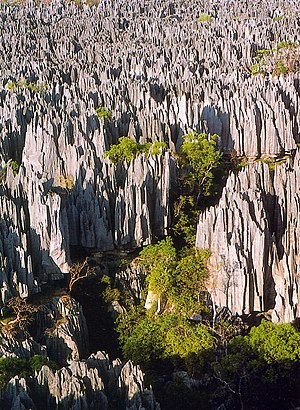Pointed cart
Pointed carts are a first-order cart structure . They arise in karst areas through solution weathering .
history
The scientific description of Spitzkarren, engl. pinnacles (battlements), begins in 1900 with M. Eckert. He was followed by Jovan Cvijić in 1924, CE Wilford & JRD Wall in 1965, MM Sweeting in 1979 and MW Longman & DN Brownlee in 1980 , among many other authors . A definition was provided by Alfred Bögli in 1951
description

Pointed carts in the Karst form pointed, projectile-like pyramids . The structures do not usually appear singularly, but form clusters. The individual pyramids are separated from one another by interlinked grooves or basin-like depressions. The individual pyramids are seldom wider than 2 meters at their base, but groupings can produce quite large complexes (in the decameter range and more). The steep side sections consist of several convex to flat facets that touch at sharp ridges and converge towards the top in a point. There are also shapes with more than one point. Grooved carts and sometimes solution ripples usually form on the facets . The height of barrows is usually in the meter range, but in tropical conditions it can go into the decimeter range.
Occurrence
Parent rocks
Pointed carts usually form in carbonate rocks ( limestone and dolomite ). But they have also been described in salt rocks ( rock salt ), very similar structures can even be found in weathered granites . The so-called penitentes , ablation structures in ice , are also very similar.
Environments
Pointed carts occur in three different environments:
- in the inland karst on bare rock (especially in high mountains)
- in inland karst under ground cover
- in the coastal area in the intertidal and supratidal zones .
The pointed carts formed under the ground cover are much more irregular than the forms created outdoors and do not have any sharp-edged facets. Their surfaces are generally smoother and more rounded. Their sides can be stamped over by steep round carts .
The most irregular of all forms are the pointed carts (littoral carts) formed on limestone in the coastal area. They are randomly furrowed, pyramidal masses, the sides of which can have overhangs and the relief of which is very roughened by cups and holes. There are also considerably more Kamenitzas between them than between the two other pointed cart shapes. They can be up to a meter high, but are usually much lower.
Emergence
It is very likely that the emergence of pointed carts represents a further development of the evolution of flat carts → cleft carts, under ground cover or outdoors. Continued action of precipitation on flat carts bounded by cleft carts widens the cleft carts more and more, so that the flat cart areas in between gradually recede in their extent and are ultimately reduced to one point (point). What remains is the projectile-shaped wheelbarrow. This development process could be verified experimentally in ablation experiments on rock prisms.
The Evolution range can be somewhat abbreviated but also via the intermediate stage formed under soil cover pillars ( english pillars done) that are exposed to after the removal of their protective layer of soil back to the normal atmospheric solution weathering (observed for example in Paläokarst the Cerro del Hierro in Andalusia , whose iron-rich soil layer had been dismantled). The limestone pinnacles , which are quite common in the tropics (especially in Southeast Asia), have taken this route. The limestone precipitation pinnacles in the Nambung National Park in Western Australia , which look very similar to them, are not a karst phenomenon, but arose from the precipitation of limestone with subsequent wind erosion .
Another evolutionary series possibly runs through Kamenitzas, which gradually broaden and penetrate more and more downwards. This was mainly observed in coastal carts, but occasionally also in inland forms.
Examples
Pointed carts occur all over the world, for example on the 1642 m high Matajur in the Julian Alps northeast of Udine , Italy.
Fine examples of littoral carts can be found on the Gower Coast in Wales . Very large limestone pinnacles and pillars have formed under subtropical conditions in Shilin and in the Lunan Stone Forest in Yunnan in southern China .
See also
Individual evidence
- ↑ M. Eckert: Wiss. Supplement. Z. Dtsch.-Österr. Alpenver. tape 31 , 1900, pp. 52-60 .
- ^ Alfred Bögli: Geogr. Helv. Volume 6 , 1951, pp. 191-204 .
- ↑ L. Jakucs: Morphogenetics of Karst Regions . Hilger, Bristol 1977.
- ↑ W. Klaer: Petermanns Geogr. Mitt., Suppl. No. 261 , 1956, pp. 146 .
- ↑ L. Lliboutry: Traité de la Glaciologie . tape 2 . Masson, Paris 1965.
- ^ F. Bauer: Actes 2nd Congr. Int. Spéléol. tape I , 1962, p. 299-328 .
- ^ RG Ley: Z. Geomorphologie . tape 32 , 1979, pp. 75-89 .
- ↑ DT Williams: AIAA J. Band 1 , 1963, p. 2384-2385 .
literature
- JRL Allen: Sedimentary structures - their character and physical basis . Elsevier, 1984, ISBN 0-444-42232-3 .
- Helmut Blume: The relief of the earth - an image atlas . Ferdinand Enke Verlag, Stuttgart 1994, ISBN 3-432-99242-4 .